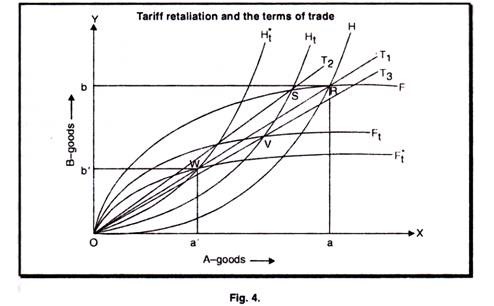Impact of Retaliation, Counter Retaliation and Tariff Wars on Trade and Volume of Trade!
The following figure 4 explains the impact of retaliation, counter- retaliation and tariff “wars” on the terms and volume of international trade R, the point of equilibrium (where two countries respective offer curves intersect) under free trade conditions.
The terms of trade are given by the slope of the line OT1. Again the home country imposes a tariff shifting its offer curve OHt hoping thereby to attain a new equilibrium at (s) and improved terms of trade OT2.
This time, however, the foreign country retaliates and imposes its own tariff on imports, thus shifting its offer curve to OF1. Equilibrium of the two tariff distorted offer curves is now (v), where the terms of trade (slope of OT1) may well be much below what the home country had originally intended by imposing its initial tariff and which may actually be somewhat more favourable to the retaliating country than were the free trade terms of trade. The result, of course, is that the initial intent of tariff has back-fired.
ADVERTISEMENTS:
The home country may now counter retaliate by again raising the tariff on its import of B-goods and the foreign country may meet this new challenge with a higher tariff of its own. This cycle of retaliation and counter retaliation may repeat itself over and over again until some point such as (w) is reached where the ultimate tariff distorted offer curves of both countries and (H*t and F*t ) intersect in such a way that, from a terms of trade stand point at least, nobody is the loser.
What has happened to the volume of trade? It has fallen from oa of the A-goods plus ob of the B-goods to oa, of A-goods plus ob1 of B- goods. The prices of import goods in both countries must have risen dramatically as a result of the successive increases in import prices and consumption has been cut down commensurately. At the same time, combined production of both countries is likely to have been substantially curtailed.
In short, if one country imposes a tariff which is not subject to retaliation it may gain at the expense of its trading partner. If the other country retaliates and especially if this leads to counter retaliation, both countries are likely to lose as a result.
The interesting implication of this principle is as follows: the smaller and economically less significant a country, the less likely it is that other countries will retaliate against any changes in its tariffs. Hence, such countries may be much more easily able to improve their terms of trade via tariff changes than large countries whose every move calls forth instant response on the part of others.
R free trade equilibrium
OT1 free trade terms of trade
OH1 home country offer curve after tariff
S equilibrium after tariff
ADVERTISEMENTS:
OT2 improved terms of trade after tariff
OF1 offer curve of the foreign country after tariff (when it wants to retaliate)
V equilibrium of the two tariff distorted offer curves
W ultimate equilibrium (Hence from the terms of trade stand point nobody is loser)
Volume of trade has fallen from oa of A-goods + ob of B-goods to oa1 of A-goods + ob1 of B-goods
Prices of imported goods must have risen dramatically in both countries due to successive increases in import duties. Consumption has been curtailed commensurately.
Combined production of both goods is likely to have been substantially curtailed.
